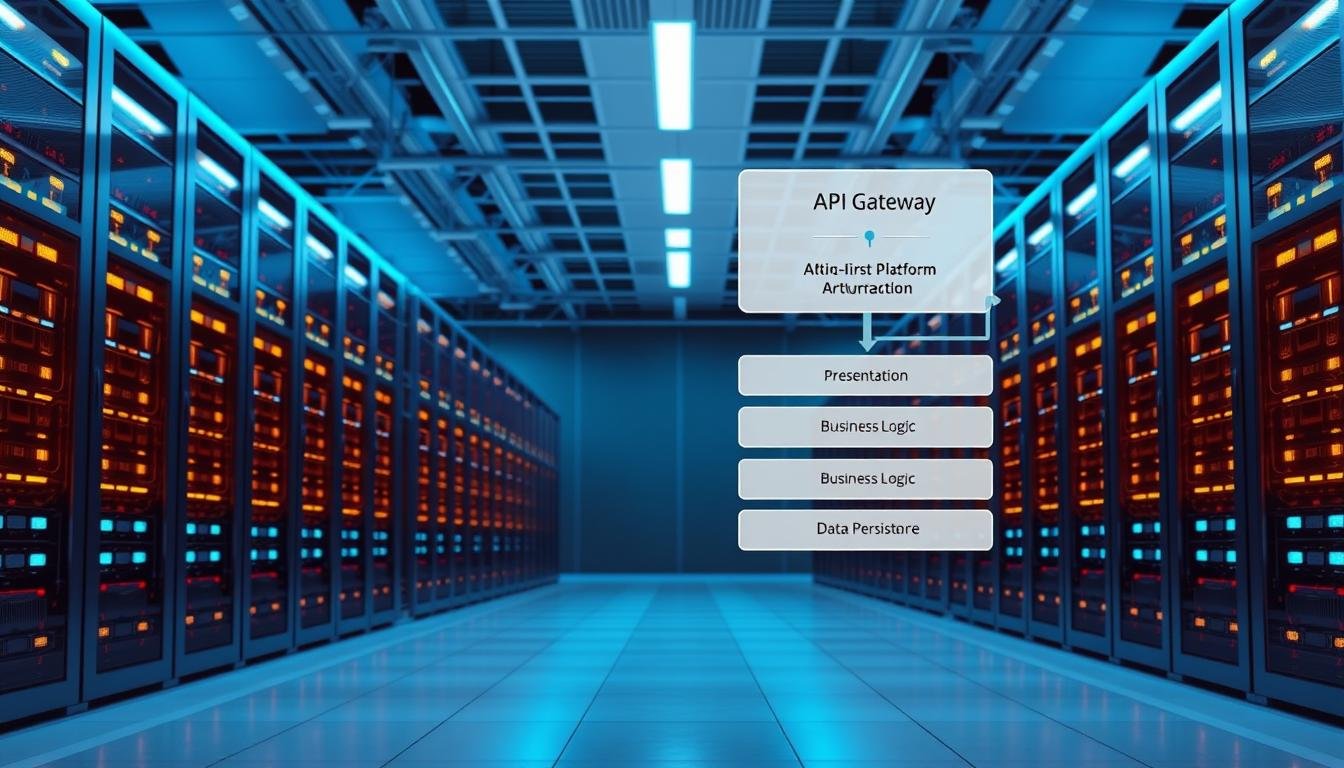What if your software could evolve from a standalone tool into an entire ecosystem? Traditional development often treats connectivity as an afterthought, but industry leaders now prioritize integration from day one. This shift isn’t just technical—it’s reshaping how businesses grow and innovate.

McKinsey Digital reports that APIs unlock partnerships, revenue streams, and innovation. Over 60 companies using this strategy secured $50M+ in funding last year, with the sector raising $14B total. By 2030, experts predict 1.7 billion active APIs worldwide—a 300% increase from today.
So how does this approach work? Instead of building features first, teams design scalable interfaces before writing other code. This creates systems that connect effortlessly with internal tools and external partners. The result? Products transform into platforms that enable entire ecosystems.
Key Takeaways
- API-centric design drives ecosystem growth, turning products into platforms
- Companies using this method raised $14B+ in funding since 2022
- 1.7B active APIs expected by 2030, signaling long-term industry shift
- Early API planning ensures seamless integration across systems
- Monetization opportunities expand through partnerships and data sharing
- Development workflows prioritize connectivity from initial design stages
Understanding the API-First Paradigm
How do leading tech teams build systems that adapt to tomorrow’s needs? The answer lies in treating connectivity as the blueprint rather than an add-on. This mindset shift transforms how organizations create value through digital infrastructure.

Defining API-First Development
In this methodology, teams design interface contracts before writing functional code. Think of it as architecting doorways before building rooms. Developers collaborate with business teams to map data flows and integration points upfront.
This proactive strategy ensures every component speaks a common language. Systems become modular, letting teams swap parts without disrupting workflows. A 2023 Forrester study found companies using this method reduced integration costs by 37% compared to traditional approaches.
Insights from Industry Leaders
Top enterprises now treat APIs as products. “Our interfaces drive 40% of partner revenue streams,” shares a Fortune 500 CTO. Early API design enables three critical advantages:
| Traditional Approach | API-First Approach | Impact |
|---|---|---|
| APIs added post-development | APIs define system structure | 83% faster integrations |
| Siloed developer teams | Cross-functional design teams | 62% fewer redesigns |
| Limited reuse potential | Shared interface library | 3x faster feature deployment |
By aligning technical and business goals early, organizations create platforms that power internal innovation and external partnerships simultaneously. The result? Systems that grow smarter with every connection.
API-first SaaS: The Core of Modern Software Solutions
Modern software solutions thrive when connectivity becomes their backbone. Unlike outdated methods that bolt integrations onto finished products, forward-thinking teams now treat interfaces as foundational elements. This shift enables systems to grow organically while maintaining compatibility across tools and platforms.

Comparing API-First and Alternative Approaches
Traditional code-first development often creates integration headaches. Teams build entire applications before considering how components will communicate. While this speeds initial prototyping, it frequently leads to:
| Approach | Integration Speed | Redesign Frequency | Feature Deployment |
|---|---|---|---|
| Code-First | 47 days average | High | Slow |
| API-First | 8 days average | Low | 3x faster |
Four implementation strategies dominate modern development:
- Design-led: Teams blueprint APIs with stakeholders before coding
- Code-led: Developers build interface contracts first
- Prototype-led: Mock APIs accelerate testing cycles
- Proxy-led: Legacy systems gain modern interfaces
The Evolution of Application Programming Interfaces
APIs have transformed from basic data pipes to intelligent connectors. Early 2000s interfaces focused on simple XML exchanges. Today’s standards like GraphQL and OpenAPI enable real-time collaboration across global systems.
Three critical advancements drive this evolution:
- Standardized documentation formats
- Automated security protocols
- Cloud-native deployment models
These innovations let developers create solutions that adapt as business needs change. Systems now anticipate integration requirements rather than scrambling to meet them.
Designing APIs as the Building Blocks of Robust Platforms
What separates functional code from future-proof platforms? The answer lies in treating interface design as engineering artistry. Well-constructed APIs act as connective tissue, enabling systems to scale while maintaining clarity across teams.
Principles of Effective API Design
Strong interfaces follow three non-negotiable rules. First: Treat your API as the primary user interface. Developers interact with endpoints before seeing your UI, so intuitive naming and error handling matter.
Second: Design contracts before writing implementation code. Teams that blueprint endpoints upfront reduce integration delays by 68% according to Postman’s 2023 State of APIs report. This approach prevents costly redesigns later.
Third: Documentation isn’t optional. Self-describing APIs with interactive guides accelerate adoption. One fintech company cut partner onboarding time from 14 days to 3 hours through Swagger-based documentation.
Navigating the API Lifecycle
Managing hundreds of interfaces requires structured governance. The API lifecycle spans eight stages:
| Stage | New APIs | Existing APIs |
|---|---|---|
| Planning | Define use cases | Assess optimization needs |
| Design | Create specifications | Version updates |
| Development | Build endpoints | Implement extensions |
| Testing | Validate functionality | Regression checks |
Engineering teams often enter at different points. New projects start with planning, while legacy integrations focus on version control. Regular audits ensure components maintain compatibility as systems evolve.
By anchoring development to these principles, organizations create platforms where functionality compounds. Clear interfaces become collaboration tools, letting teams build upon each other’s work without reinventing foundations.
Leveraging API Platforms for Scalability and Integration
How do organizations manage hundreds of interconnected systems without chaos? Modern API platforms act as command centers, combining lifecycle management with collaborative workflows. These systems empower teams to scale integrations while maintaining control over evolving technology stacks.
Key Components of an API Platform
Effective platforms rest on four pillars. First: lifecycle tools covering design, testing, and monitoring. Developers use mock APIs to prototype features before writing code, while automated testing catches errors early.
Second: Collaboration hubs like API catalogs let teams share reusable components. “Our catalog cut duplicate work by 40%,” notes a tech lead at a Fortune 500 firm. Third: Governance modules enforce security policies and track performance metrics across services.
Fourth: Native integrations connect to CI/CD pipelines and cloud infrastructure. This bridges gaps between development and operations teams, letting them deploy updates without breaking existing integrations.
Streamlining Development Processes with Integrated Tools
Unified platforms eliminate tool fragmentation. Instead of juggling 12 separate apps, developers work within one environment handling:
- Real-time API documentation updates
- Automated security scans
- Usage analytics dashboards
These features reduce onboarding time for new team members by 65%, according to recent DevOps research. Integration with source control systems like Git ensures code changes align with API contracts.
By centralizing management tasks, platforms free developers to focus on innovation. Teams ship features faster while maintaining compatibility across services—a critical advantage in fast-moving markets.
Business Advantages of an API-First Approach
Strategic integration unlocks business potential that traditional development models struggle to match. By prioritizing connectivity from inception, organizations create value that compounds through partnerships and operational efficiency.
Monetization and Strategic Partnerships
Companies using this methodology report 42% higher revenue from partner ecosystems compared to competitors. Three monetization models dominate:
- Access tiers: Charge based on API call volume or feature access
- Revenue sharing: Split profits from third-party integrations
- Marketplace models: Enable partners to resell API-powered solutions
A leading payment processor generated $380M last year through API partnerships—28% of total revenue. These collaborations reduce customer acquisition costs while expanding market reach.
Enhancing Developer Productivity and Software Quality
Development teams achieve 57% faster release cycles when using standardized interfaces. Key benefits include:
- Automated testing catches 89% of bugs before deployment
- Reusable components reduce redundant coding by 63%
- Centralized documentation cuts onboarding time by 75%
One logistics company reduced production incidents by 91% after adopting interface-first development. Quality engineers now resolve issues in 2.7 hours average—down from 19 hours previously.
Industry Trends and Real-World Applications
Across industries, modern connectivity strategies are rewriting operational playbooks. Organizations now harness APIs to solve sector-specific challenges while unlocking new revenue streams. Three verticals demonstrate this transformation most vividly.
Sector-Specific Benefits: Healthcare, Banking, and Travel
Healthcare systems use APIs to securely share patient records across providers. Epic Systems’ interfaces enable 250+ hospitals to integrate data while maintaining HIPAA compliance. This reduces duplicate tests and improves treatment accuracy.
Financial institutions leverage APIs for real-time fraud detection and payment processing. Stripe’s infrastructure processes billions in transactions monthly through developer-friendly endpoints. Open banking regulations now require banks to expose core services via standardized interfaces.
Travel platforms connect fragmented services through unified APIs. Amadeus powers 40% of global flight bookings with systems that link airlines, hotels, and rental agencies. Users book complex itineraries through single interfaces.
Investment Trends and Market Momentum
Venture capital flows confirm this shift’s strategic value. In 2022 alone:
- 60+ tech firms focusing on API solutions secured $50M+ funding rounds
- The payments-as-service sector grew 28% YoY
- Enterprise API spending surpassed $14B globally
Analysts project the global API economy will reach $25.7B by 2027. This growth stems from clear ROI: Companies using strategic integrations report 42% faster time-to-market for new services compared to peers.
Integrating API-first with UX and Team Collaboration
Balancing technical infrastructure with user-centric design defines modern software success. Platforms thrive when robust connectivity aligns with intuitive interfaces and cohesive teamwork. This integration transforms how organizations deliver value at scale.
Blending API Functionality with Exceptional User Experience
APIs power seamless interactions users never see but always feel. Efficient backend systems enable faster load times, real-time updates, and personalized features. A travel app using smart endpoints reduced booking steps by 60% while maintaining complex itinerary logic.
Designers now collaborate with developers during API planning. Joint workshops ensure interfaces support both technical requirements and user journeys. This alignment helped one fintech firm achieve 42% faster feature deployment without compromising usability.
Fostering Cross-Team Collaboration and Governance
Breaking silos between departments accelerates innovation. Shared documentation hubs and version control systems keep product, engineering, and design teams synchronized. Regular “integration sprints” surface issues early, cutting redesign costs by 31%.
Effective governance balances flexibility with standards. Role-based access controls and automated compliance checks maintain security without slowing progress. Teams using these practices report 75% fewer production incidents related to interface changes.





